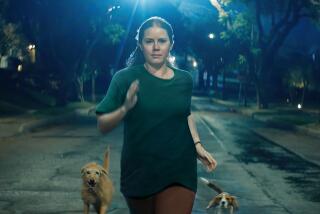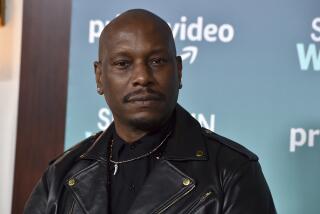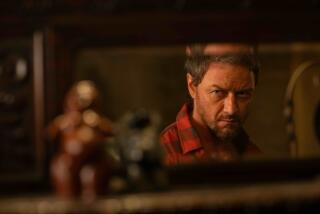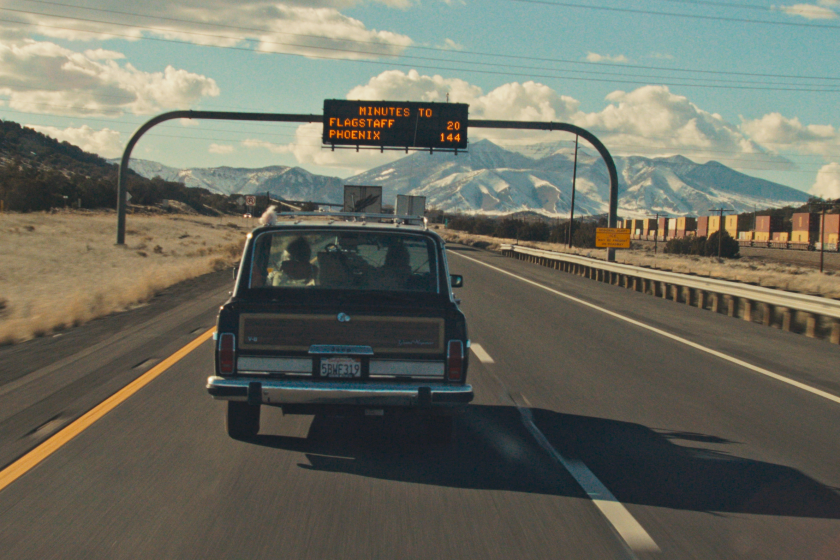When Shooting Starts, He’s Mr. Efficiency : Eastwood’s Malpaso ‘family’ generally does the job on time and under budget
It was late November in the quiet Sierra Nevada town of Greenville. For two weeks, the cast and crew of “Pink Cadillac,” the forthcoming action romance featuring Clint Eastwood and Bernadette Peters, enjoyed cloudless skies and unseasonable temperatures in the mid-80s.
Then the weather changed. After the crew spent two days shooting a complicated auto chase sequence along scenic Highway 89, the temperature plummeted 55 degrees overnight. As the production crew assembled at the location site the next morning, snow blanketed the region.
Eastwood, whose own Malpaso Prods. was making the film, conferred with director Buddy Van Horn. The crew had two options: It could wait out the weather as expenses accrued or move to the next location in Sacramento a fortnight early. The auto chase might have to be filmed again somewhere else or picked up the following spring.
It was the kind of dilemma and pressure that Eastwood, according to reputation, handles with skill and aplomb. Although hardly turning out blockbusters in recent years (see the accompanying glimpse of his more recent box-office grosses), he’s become known for filming with remarkable speed and economy. Of the 26 films Malpaso had made since 1968, not one had finished behind schedule or over budget.
But would that record end with “Pink Cadillac,” the story of Sacramento bounty hunter Tom Nowak (Eastwood), who gets involved with a young woman (Peters) on the lam in a ’59 convertible DeVille?
After all, snow was not the only impediment to production. A 10-day industrywide Teamsters strike was a problem in the early weeks of production, which had started in nearby Reno on Oct. 3. And the accommodations in Greenville proved to be a logistical nightmare: 115 cast and crew members were housed as far away as 26 miles in either direction of the central shooting sites, with many key people stranded without phones or transportation.
As winter approached, shooting days were abbreviated by an early sunset, sometimes at 3 p.m., when the sun dropped behind the Sierra peaks. And though no one knew it yet, the last two weeks in Greenville would be cursed with virtually unabated hail, sleet and rain.
But the snow came first.
Eastwood, 58, decided there was a way to shoot through it. That morning, close-ups of the five drivers (including Eastwood, doing his own stunt work) were shot with the wintry background out of focus. Later, after a half-mile, pine-enclosed stretch of highway had been swept clear, camera angles were devised to minimize the telltale white on the nearby landscape. It was enough to keep “Pink Cadillac” in business, at least until the snow dissipated over the following days.
“Yeah, we had a few difficulties,” Eastwood later remarked with typical understatement. “But we just did our best to get around them.”
“Pink Cadillac,” which opens Friday, finished three days ahead of schedule and some $600,000 under budget, said producer David Valdes.
Most Eastwood shoots finish early, Valdes said. The projected timetable for “Sudden Impact” (1983) was 48 days; principal photography was completed in 39. “Tightrope” (1984): 54 days vs. 46. “Pale Rider” (1985): 55 vs. 48. “Heartbreak Ridge” (1986): 51 vs. 45. “Bird” (1988): 50 vs. 44.
“People think of Clint Eastwood as a movie star,” said Terry Semel, president of Warner Bros., Eastwood’s studio affiliation for the last 14 years, “and they’re beginning to know him as a director as well. But behind all that, he is in effect the chairman of his Malpaso company and he oversees every inch of every one of his films. During his tenure here, he has been the most reliable and organized maker of films we’ve dealt with.”
“Clint just has an extremely responsible way of working,” Valdes said. “He spends each dime as if it were his own.”
Eastwood’s craft and crew members, while essentially independent, return to Malpaso film after film. Some have been on hand ever since Eastwood’s tenure as a regular on the 1959-66 “Rawhide” TV series. Director Buddy Van Horn has been with Eastwood for 21 years. Valdes for 10. Cinematographer Jack Green for 18. Editor Joel Cox for 14.
“Knowing everyone’s little idiosyncrasies and personalities can only make for a stronger family,” Green said. “And that’s really what it is, the ‘Malpaso family.’ ”
“It’s as much a democracy as it possibly can be,” Eastwood said. “Every job is important and there should be respect for every job. Without any of those jobs, everything can fall apart.”
Eastwood also welcomes any ideas or suggestions on the set. “If I have any qualities as a film maker that work,” he said, “it’s that I try to stimulate everyone to be as creative as they possibly can. I like them to contribute to the film and not just do their jobs by rote. It makes for a better atmosphere and a better film. Like if I come in and play big shot and say, ‘This is the way I want it and I don’t want to hear anything else,’ I mean, that’s just so shortsighted.
“I’ve just seen a lot of waste in this business,” said Eastwood. “A waste of money, of time, of good talent, even. I just thought with (Malpaso) there could be some kind of alternative there.
“You know, with a lot of pictures, you don’t see the expense on the screen. A picture that may have cost $15 million may look more like six. A picture should at least look comparable in overall technical quality as the budget that went in to it.”
“Bird,” the Eastwood-directed, 2-hour, 40-minute meditation on the life of jazz great Charlie Parker, presented its own set of logistical challenges (elaborate, expensive, digitally processed musical tracks, for one, that had to be completed prior to the principal photography). But the period drama (primarily the 1940s and ‘50s) was
priced out by Eastwood at $10.1 million, which also included the cost for a sound track album and a last-minute promotional video.
“I think any studio would ordinarily have spent at least twice the money to make ‘Bird,’ ” said Warner Bros.’ Semel, “and that includes ourselves.”
By the time “Pink Cadillac” is in theaters across the country over the Memorial Day weekend, Malpaso will have released three films--including “Bird” and “The Dead Pool”--within 12 months.
“Most major directors or actors will take a hiatus after a film of maybe six months or a year,” said Semel. “Sometimes longer. But Clint likes to keep working and doing it in these various functions, as actor, director, producer or a combination of these functions.
“On May 28, he’s leaving for Africa to start his next project (“White Hunter, Black Heart”), in which he will both direct and act. And he already has a very good idea of what his film to follow that will be.”
Eastwood’s films have grossed well over $1.75 billion in the last 2 1/2 decades and have come to represent, by Semel’s estimates, anywhere from 10% to 20% of Warner’s annual revenues for motion pictures. This does not include the $1.5 million that reportedly enters the studio’s ledgers every week for worldwide ancillary--non-theatrical--distribution.
(The details of Eastwood’s personal finances may come to light if a palimony suit filed by longtime companion Sondra Locke ever comes to trial. After more than 13 years together, Eastwood changed the locks on the Bel-Air home the two had shared together. In turn, Locke sued Eastwood for unspecified financial support, breach of contract, emotional distress, forcible entry and other claims.)
“I’ve just always felt that the less you spend, the more there is to go around,” Eastwood said. “A lot of people are shortsighted about that. They’d rather take what they’ve got and work the production and the studio for all it’s worth. I’d rather see what can be saved. I think if more people did that, there’d be more productions in business and more movies made.”
While Eastwood likes to work quickly to deflect costs, he also believes it builds creative momentum.
“Movie making to me is something that happens in the present tense,” he said. “I find with a lot of films, if they’re overly set up, or if the director insists on a lot of takes, or if things just move along real slow, the lack of energy shows. They become vacant films. They’re technically nice but their soul is gone.
“I just like to keep everything moving, keep everything alive, so that you make decisions on reflex, without overthinking it. The more time you have to think things through, the more you have time to screw it up.”
Consequently, as an actor, he eschews much rehearsal time. “I like to go for the take,” he said.
The dailies--raw, unedited footage--from “Pink Cadillac” evidence the performance technique Eastwood describes. In one scene, Eastwood and Peters are riding in the big pink DeVille. Their characters, Nowak and Lou Ann McGuinn, are just now overcoming an earlier mutual antagonism.
“So tell me about yourself,” she says. Nowak slowly starts to speak. “No, no, let me guess,” Lou Ann interrupts, laughing. “You’re--an American wildcat. Your kind does not breed under captivity. . . .”
As several camera takes are repeated on screen two, three, maybe four times, the actors seem to discover--via a glance, a pause, different emphasis--new shadings and inflections within the same scene. This is acting meant to be immediate, never schematic.
“It was in that scene,” Peters, 41, later commented, “that how Clint works really came together for me.
“Because I’d heard that (Malpaso) doesn’t do a lot of takes, and I was worried about that. But then I just fell into the swing of it, which is to capture the moment by what happens.
“You can’t do that with every actor, but Clint is so right there, that he makes it easy, to work off each other. I learned a lot from him in doing this movie. It was a good lesson he taught me.
“And you do work fast, which Clint has a theory about. It’s so you don’t hang around all day waiting for the set-ups. You don’t get sluggish. You don’t get distracted or lose interest. You don’t forget where you are.
“It’s a good way to work.”
To further promote momentum, Eastwood has long advocated the “French system” of production.
“It works so that in your agreement with the (labor) unions,” he said, “shooting is limited to 10 hours but there’s food available throughout the day. That way, you never stop for an official meal break and have the usual inertia that follows afterward.”
But the momentum and speed that Eastwood nurtures doesn’t mean there’s a frantic rush between set-ups. “It’s so relaxed,” said Peters, a veteran of 11 films, “and that’s so unusual. There’s no pressure at all. I just said to myself, ‘Oh, boy. This is great. I’m just going to enjoy it.” Eastwood has a standing ambition to make a film in the wilderness. He calls it “the John Ford approach.”
“I’ve suggested, though it never seems to work out,” he said, “doing a film in his tradition, where you take a crew and go live in tents. You know, go out some place like Monument Valley where you drink out of the river and build campfires at night. Do that kind of thing for a Western or something. Get out in the middle of nowhere and outside your tent is the horse you ride the next day. But it’s a very hard thing to pull off anymore.”
For a while, it seemed like Eastwood might get to do it with his forthcoming “White Hunter, Black Heart.” Loosely based on the adventures of John Huston during the production of “The African Queen” in 1951, the script was written by Peter Viertel, who was with Huston at the time. Eastwood will play the Huston-like protagonist and also direct.
“I thought maybe we could camp out in the jungle or something like that,” Eastwood said, “but it’s actually more expensive to do that than to get more conventional lodgings and, in this case, not really that practical from a production standpoint.
“But it’s a good story, I think. The ‘Huston guy’ gets obsessed with hunting a bull elephant while he’s out making his film. It’s kind of got this anti-hunting and poaching theme to it. It’s also about some of the excesses of the movie business that were sometimes common even back then.
“I don’t know what kind of problems we’ll run into on this one. Maybe snakes in the river. Or signal ants through the set. It’ll be interesting.”
More to Read
Only good movies
Get the Indie Focus newsletter, Mark Olsen's weekly guide to the world of cinema.
You may occasionally receive promotional content from the Los Angeles Times.






